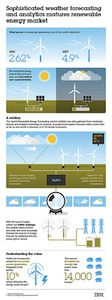IBM has announced the launch of an advanced power and weather modeling technology that will help utilities increase the reliability of renewable energy resources. According the company, the solution, “Hybrid Renewable Energy Forecasting” (HyRef) combines weather predictions and analytics to accurately forecast the availability of wind power and solar energy. This will enable utilities to integrate more renewable energy into the power grid.
 IBM says HyRef uses weather modeling capabilities, advanced cloud imaging technology and sky-facing cameras to track cloud movements, while sensors on the turbines monitor wind speed, temperature and direction. When combined with analytics technology, the data-assimilation based solution can produce accurate local weather forecasts within a wind farm as far as one month in advance, or in 15-minute increments.
IBM says HyRef uses weather modeling capabilities, advanced cloud imaging technology and sky-facing cameras to track cloud movements, while sensors on the turbines monitor wind speed, temperature and direction. When combined with analytics technology, the data-assimilation based solution can produce accurate local weather forecasts within a wind farm as far as one month in advance, or in 15-minute increments.
“Utilities around the world are employing a host of strategies to integrate new renewable energy resources into their operating systems in order to reach a baseline goal of a 25 percent renewable energy mix globally by 2025,” said Vice Admiral Dennis McGinn, President and CEO of the American Council On Renewable Energy (ACORE). “The weather modeling and forecasting data generated from HyRef will significantly improve this process and in turn, put us one step closer to maximizing the full potential of renewable resources.”
By utilizing local weather forecasts, according to IBM, HyRef can predict the performance of each individual wind turbine and estimate the amount of generated renewable energy. This level of insight will enable utilities to better manage the variable nature of wind and solar, and more accurately forecast the amount of power that can be redirected into the power grid or stored. It will also allow energy organizations to easily integrate other conventional sources such as coal and natural gas.
HyRef represents advancements in weather modeling technology, stemming from other game-changing innovations such as Deep Thunder. Developed by IBM, Deep Thunder provides high-resolution, micro-forecasts for weather in a region – ranging from a metropolitan area up to an entire state – with calculations as fine as every square kilometer. When coupled with business data, it can help businesses and governments tailor services, change routes and deploy equipment-to minimize the effects of major weather events.

